We will soon be celebrating the Winter Solstice in the Southern Hemisphere. However, in the Northern Hemisphere, the Winter Solstice occurs in December, just a few days before our modern celebration of Christmas on December 25. Christmas icons, stories and traditions are heavily influenced by seasonal pre-Christian folklore and folk practices, which we explored in last week’s article, Echoes from the Ice Age: The Winter Solstice and Mother’s Night.
In today’s episode, we will explore the impact of Christianity on Winter Solstice celebrations, the effect of Nordic and Germanic culture on British Christmas traditions, the Puritan repression of Christmas, and its subsequent revival in the Victorian era. We’ll then delve into the concept, as well as the carol of the Twelve Days of Christmas and finally, explore Twelfth Night traditions.
The Origins of Christmas
Christ Mass
The spread of Christianity in Europe began in the 1st century CE. It originated in the eastern Mediterranean region, specifically in the Roman province of Judea in Palestine, and quickly gained followers within the Roman Empire. The early Christian movement expanded primarily through the efforts of the apostles and missionaries who travelled across the Mediterranean, spreading the teachings of their prophet Jesus Christ. Over time, Christianity gained acceptance and eventually became the dominant religion of the Roman Empire, leading to its spread across Europe and beyond. The process of Christianisation took several centuries, with different regions and peoples adopting the Christian faith at different times.
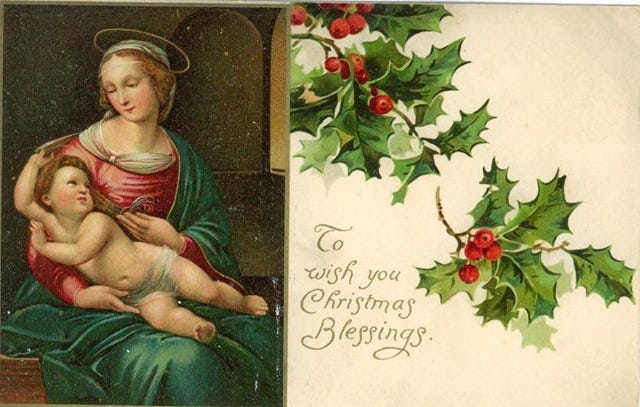
As Christianity spread across North and Western Europe, the early Church sought to assimilate and syncretise existing pagan traditions to align with Christian beliefs. By strategically adopting and adapting elements of pagan seasonal celebrations and customs, the Church aimed to ease the transition to the Christian faith for the local populations and provide a familiar framework for their spiritual practices. The timing of Christmas, for instance, was deliberately chosen to allow Christian religious observances and meanings to replace the ‘pagan’ traditions of the winter solstice and was called the Christ Mass, which became Christmas. Many of the rituals, symbols, and themes associated with the winter solstice, such as the lighting of candles, the decoration of evergreen trees, and the emphasis on light and rebirth, were gradually infused with Christian symbolism and given new meaning within the context of the birth of Jesus Christ.
Christianity spread to much of Roman Britain but did not gain any traction in the Welsh and southwestern peninsula regions, nor was it successful in converting the people of the modern-day Irish and Scottish regions. These areas held onto their Indigenous polytheistic belief systems until much later, starting in the 5th century, well after the fall of the Western Roman Empire.

It might be surprising to learn that the date of Jesus’ birth was an invention and part of the effort to Christianise pagan winter solstice mythology. Niall Edworthy wrote in his book, The Curious World of Christmas (2008), that:
Nowhere in the Gospels or the writings of the early Christians is there any mention of Christ’s birthday. It was several centuries after his lifetime that the date became a matter of conjecture and argument. This was partly because early Christians had no interest in birthdays. The Epiphany (today, January 6) was of greater importance in the Eastern Churches, this was the day for celebrating Christ’s baptism; in the West it was to commemorate the manifestation of Christ’s glory and his revelation to the Magi.
Some early Christians even took exception to the recognition of birthdays because it distracted from their more significant “death days,” when saints were martyred and Christ had given his life for mankind. Exactly when the Church decided upon December 25 as the birth date of Jesus is unclear, but it almost certainly came to be accepted as that during the fourth century, possibly during the reign of Constantine, the first Christian Roman emperor (p. 15).
Christmas in Britain — Anglo-Saxons
The Roman Empire was vast but began to disintegrate by the fourth century CE. Rome struggled to maintain its foothold across its Empire, particularly in its more distant regions. In England, Rome was constantly defending against raids by Saxons, Picts and the Irish Scoti. It also needed to defend against incursions of Gauls and Germanic tribes on the European mainland and internal rebellion from their mostly Germanic troops. By 410 CE, the Roman military withdrew from Britain or deserted their posts due to a lack of pay and resupply. British land was divided and ruled by British warlords but they continued to be harried by attacks from the Picts, Scoti and the Germanic tribes. Pagan Saxons from Old Saxony in Northern Germany, Angles from Anglia along the modern Danish-German border and Jutes from Jutland, now a part of Denmark, were invited by British warlord, Vortigern, to help fight the Picts and Scoti in exchange for land in the East of Britain. These Anglo-Saxon mercenaries rebelled and plunged the country into a series of wars. Anglo-Saxon warlords eventually occupied Lowland Britain by 600 CE and Anglo-Saxon migrants brought their traditions and culture with them.
Early 20th-century writer and avowed Christian, W. F. Dawson wrote about the effect of the Anglo-Saxon invasion of Great Britain on the Roman Christian celebration of Christmas in his book Christmas: Its Origins and Associations (1901):
The outgoing of the Romans and the incoming of the Angles, the Saxons and the Jutes, disastrously affected the festival of Christmas, for the invaders were heathens, and Christianity was swept westward before them. They lived in a part of the Continent which had not been reached by Christianity nor classic culture and they worshipped the false gods of Woden and Thunder and were addicted to various heathenish practices, some of which are mingled with the festivities of Christmastide… The Anglo-Saxon excesses are referred to by some of the old chroniclers, intemperance being a very prevalent vice at the Christmas festival. Ale and mead were their favourite drinks; wines were used as occasional luxuries.
These traditions, originating from old Nordic and Germanic belief systems, were celebrated throughout Anglo-Saxon Britain for over 300 years and we will explore the Nordic and Germanic midwinter celebration of Yule over several articles during July. However, by the English Medieval period in the seventh century, missionaries from Rome converted the Anglo-Saxon aristocracy to Christianity and eventually infiltrated the daily lives of the common folk.
“The pagan hierarchical structure disintegrated rapidly in the seventh century in the face of Christianity’s systematic organization. But folk practices were all-pervasive in everyday life. The animistic character of Germanic belief prior to Christianization, with its emphasis on nature, holistic cures, and worship at wells, trees, and stones, meant that it was hard to counteract on an institutional level of organized religion… The synthesis of Christian and Germanic ideas gradually transformed these practices, undoubtedly at the local level… In this way Christianity ultimately penetrated the homes and daily lives of the various Germanic peoples in the centuries after the arrival of the first missionaries.”
Karen Louise Jolly (1996). Popular Religion in Late Saxon England: Elf Charms in Context. Chapel Hill: University of North Carolina Press, p.45.
By the time Viking raiders began their attacks on Britain and Ireland in the late 8th Century, the Christian celebration of Christmas was entrenched.
Christmas in Britain — Vikings
Vikings from Scandinavia, what is now Norway, Sweden, and Denmark, began raiding England by sea and river in 793 CE. They targeted the treasures kept in English monasteries and enslaved thousands of people, particularly in Ireland. Some Viking raiders eventually settled in England becoming traders, farmers, and fishermen, although many still raided throughout the British Isles and waged war against English kingdoms. In 878 CE, a large army of Vikings led by warlord Guthrum was defeated by Alfred the Great of Wessex, in a battle known famously as the Battle of Eddington. A treaty was signed, with Viking settlers agreeing to refrain from challenging English lords in return for establishing the Danelaw across a large swathe of central and eastern England.

The influx of Danes or Norsemen reintroduced customs, celebrations, and traditions to England that were similar to the pre-Christian Anglo-Saxons. Danish rule was finally ended by the Norman invasion of William the Conqueror in 1066 CE. Although descended from Anglo-Saxons who settled in Francia and Normandy, the Normans were renowned for their Catholic piousness and England again became a Christian nation. Christmas celebrations returned, though re-coloured with Christian beliefs and converted symbolism.
A Puritan Christmas
Christmas continued to be celebrated in England, merging ‘pagan’ festivities and traditions with Christian observances and iconography until the 16th and 17th centuries. In the 16th century, Calvinist Scots banned the ‘pagan’ excesses of Christmas in Scotland and the Puritans did the same in England a hundred years later. As no mention of Christmas was made in the bible, Oliver Cromwell’s administration banned all Christmas celebrations, through an Act of Parliament in 1644. The Puritans did the same in America, particularly in New Plymouth, Connecticut and Massachusetts Bay. Massachusetts went to the extent of outlawing the celebration of Christmas in 1659.
For preventing disorders arising in several places within this jurisdiction, by reason of some still observing such festivals as were superstitiously kept in other countries, to the great dishonor of God and offence of others, it is therefore ordered by this Court and the authority thereof, that whosoever shall be found observing any such day as Christmas or the like, either by forbearing of labor, feasting, or any other way, upon such accountants as aforesaid, every person so offending shall pay of every such offence five shillings, as a fine to the county. Records of the Governor and Company of the Massachusetts Bay in New England. 1659.

In both Britain and the US, Christmas became a day of work and fasting until 1660 in England, when the monarchy was restored under King Charles II after popular unrest and street riots opposing the Christmas bans. The Puritan disdain for Christmas lasted a bit longer in the US, with Christmas gradually becoming universally accepted by 1840. It was finally recognised as a national holiday in 1870, although its more raucous traditions were substantially toned down.
The Victorian Christmas Revival
Christmas remained a quiet, religious observance until the mid-1800s when a confluence of Victorian-era romantic antiquarianism spread through the United Kingdom and the British colonies in Canada and America. This was precipitated by several events including Queen Victoria importing German Christmas traditions to England for her German husband Prince Alfred. We will revisit Queen Victoria’s impact on the revival of Christmas in a future article about Yule and the Yule Tree.
The publication of several stories and poems during this period also strongly influenced the Christmas zeitgeist. In 1823 American poet Clement Clark Moore published his famous and still popular poem, The Night Before Christmas, which established the figure of Santa Claus in Christmas mythology. Charles Dickens published A Christmas Carol in 1843, and American writer Washington Irving’s Old Christmas, a collection of Christmas stories was published in 1875, further cementing Christmas celebrations into popular culture. The Victorian era also repositioned Christmas as a celebration of family centred on the indulgence of children and childhood and encouraged philanthropy amongst the burgeoning middle classes.

Happy, happy Christmas, that can win us back to the delusions of our childish days; that can recall to the old man the pleasure of his youth; that can transport the sailor and the traveller, thousands of miles away, back to his own fireside and his quiet home! Charles Dickens (1812–1870) The Pickwick Papers.
The invention of commercially produced Christmas cards in 1843 further entrenched Victorian Christmas traditions that continue to this day, and influenced the popularity of Christmas symbols and icons.


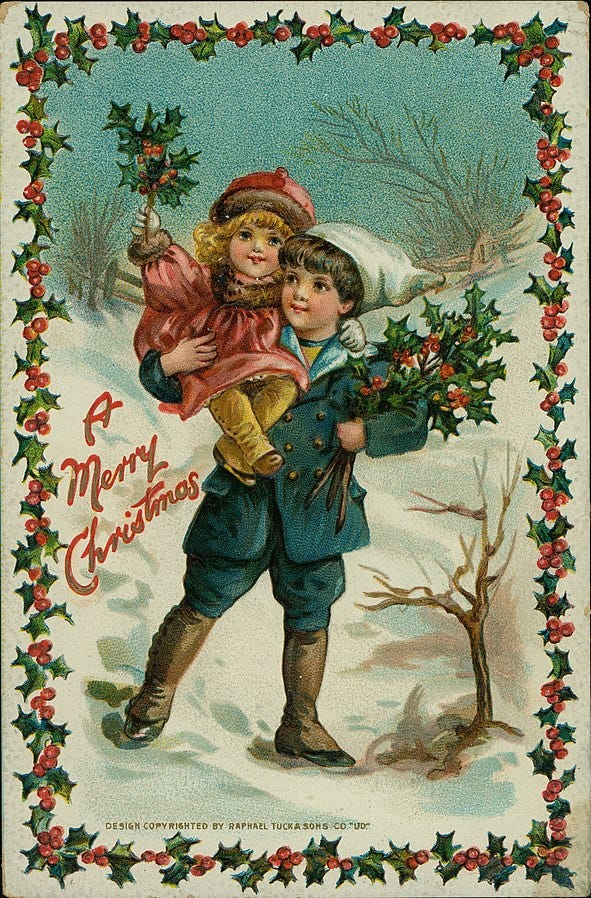
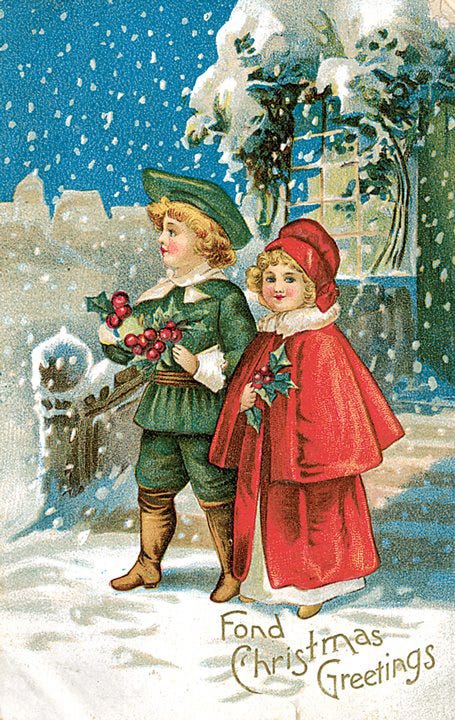
Although the revived Christmas echoed older winter solstice and mid-winter celebrations, it omitted many customs in favour of what was available to most of the middle class of that era.
‘Instead of toast and ale, we content ourselves with sherry and chestnuts, and we must put up with coffee and fragrant tea, instead of the old Wassail-bowl.’ The boar’s head was replaced by ‘the roast beef of old England, a turkey or a goose,’ together with a plum pudding, all of which ornamented ‘the table of the peasant or artisan, for which he had during some previous weeks been preparing’ J.M Golby and Purdue. (2000). The Making of a Modern Christmas. Sutton Publishing, p.57.
This short 2:55 minute video from History Channel’s Bet You Didn’t Know, has a lot of information about the history of Christmas for those short on time.
The Twelve Days of Christmas
The Twelve Days of Christmas is commonly believed to be a Christian tradition beginning with the birth of Jesus on December 25th (Christmas Day) and lasting until January 5th, also known as Twelfth Night or Epiphany. However, the traditions surrounding the Twelve Days and Twelfth Night have their roots in much older pre-Christian traditions.
Ancient Nordic and Germanic peoples, including their modern forbears the Anglo-Saxons in England and the Vikings, began their midwinter celebrations starting on the night of the winter solstice, around 21 December in the Northern Hemisphere. These festivities lasted until the first full moon after the solstice and involved much feasting, drinking and ‘making merry’ during the coldest and darkest time of year. Celebrations lasting several weeks were also an important aspect of the ancient Roman winter solstice celebration of Saturnalia.
As we learned in the previous article, Echoes of the Ice Age: the Winter Solstice and Modranicht, Saturnalia festivities began on the 17th of December¹ and involved sacrifices in honour of the god Saturn, followed by public banquets, private gift-giving and continual partying on the streets and in homes. The festivities climaxed on 25 December (winter solstice in the old Julian calendar) with Dei del Sol Invictus (Birthday of the Invincible Sun), culminating with Kalends on 1 January and the start of the new year.
All levels of Roman society participated in the festivities, in which no work or business was conducted, social norms were overturned, gambling was allowed, roles were reversed, clothes were swapped between freemen and slaves, and masters served their slaves food. During public gatherings and for festivities in the home, a ‘king’ or ruler of Saturnalia, the Saturnalia princeps, ruler of chaos, was appointed by lot and was responsible for making mischief such as insulting guests, wearing animal skins, chasing women and issuing capricious orders.
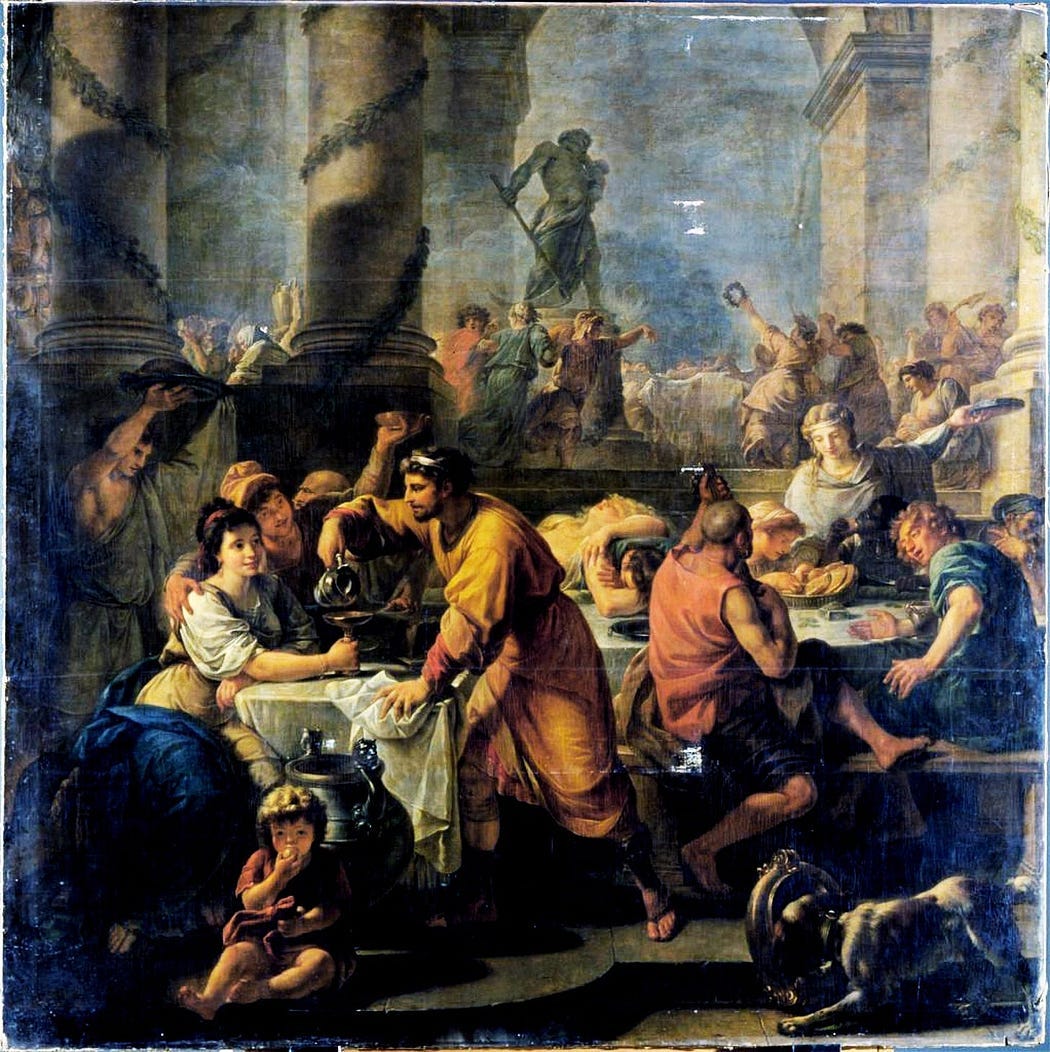
Twelve Days of Christmas in the Middle Ages
By the Middle Ages, the Christian fasting month of Advent was an important custom throughout Europe. Advent finished on Christmas Eve and Christmas Day, December 25, marked the start of 12 days of celebration until the night before Epiphany on January 5. During this time, in much the same way as Saturnalia, serfs and servants were allowed twelve days off work, gambling and public drinking were permitted, and raucous and lewd behaviour was tolerated.
As we’ve already seen previously, Calvinist Scots, and English and American Puritans vehemently opposed the celebration of Christmas. Not only did they argue that Christmas was not mentioned in the bible but that Christmas celebrations were marked by ‘debauchery, drunkenness, gluttony, gambling, licentious behaviour and pagan practices’.
The Twelve Days of Christmas (Carol)
Although the Twelve Days of Christmas are no longer celebrated in their entirety, many places celebrate Christmas as well as Twelfth Night or Epiphany. Echoes of the Twelve Days of Christmas tradition are found in a Christmas carol that has remained popular for hundreds of years. According to historical accounts, The Twelve Days of Christmas was originally played as a memory-and-forfeits game, where participants recited each cumulative verse, sometimes in one breath. If a player made a mistake or forgot a verse, they had to pay a penalty, such as offering a kiss or a treat.
British folklorist and pioneer in the study of children’s games, Lady Alice Gomme, published descriptions of over 800 children’s games in two volumes of her book, The Traditional Games of England, Scotland and Ireland (1894 & 1898).
“The Twelve Days” was a Christmas game. It was a customary thing in a friend’s house to play “The Twelve Days,” or “My Lady’s Lap Dog,” every Twelfth Day night. The party was usually a mixed gathering of juveniles and adults, mostly relatives, and before supper — that is, before eating mince pies and twelfth cake — this game and the cushion dance were played, and the forfeits consequent upon them always cried. The company were all seated round the room. The leader of the game commenced by saying the first line. […] The lines for the “first day” of Christmas was said by each of the company in turn; then the first “day” was repeated, with the addition of the “second” by the leader, and then this was said all round the circle in turn. This was continued until the lines for the “twelve days” were said by every player. For every mistake a forfeit — a small article belonging to the person — had to be given up. These forfeits were afterwards “cried” in the usual way, and were not returned to the owner until they had been redeemed by the penalty inflicted being performed.
The earliest documented appearances of the lyrics for The Twelve Days of Christmas can be traced back to two sources. One is an illustrated children’s book titled Mirth Without Mischief, which was published in London in 1780. The other is a broadsheet by Angus of Newcastle, believed to be from the late eighteenth or early nineteenth centuries.

The carol has been set to various melodies over time, with the most recognizable versions stemming from a 1909 arrangement of a traditional folk melody by English composer Frederic Austin. A modern version of The Twelve Days of Christmas is sung by the Pentatonix in the video (3:20 mins) below.
Twelfth Night
Epiphany on January 6, was believed by Christians to be the day the wise men or Magi arrived in Bethlehem and met the newborn Jesus. The night of January 5, Epiphany Eve more popularly called Twelfth Night, was marked by feasting and revelry in which a temporary Lord or King of Misrule was appointed, usually by lot or the King Cake custom.
The King Cake
The King Cake is a ring-shaped cake made from rich, yeasted dough often flavoured with spices. A small trinket, figurine, or dried bean known as a fève (French for bean) is baked into the cake, representing the baby Jesus. The three spices used in the recipe, usually ginger, nutmeg and cinnamon, represent the Magi. Whoever discovers the trinket or bean in their slice is crowned the ‘king’ or ‘queen’ of the festivities and given a golden paper crown to wear. The Twelfth Night King or Queen can act as the jester during the rest of the festivities. They are also responsible for hosting the next gathering or providing the King Cake for the following year. The King Cake tradition is still popular in Germany, France, Spain, and Portugal, and various regions influenced by these cultures.


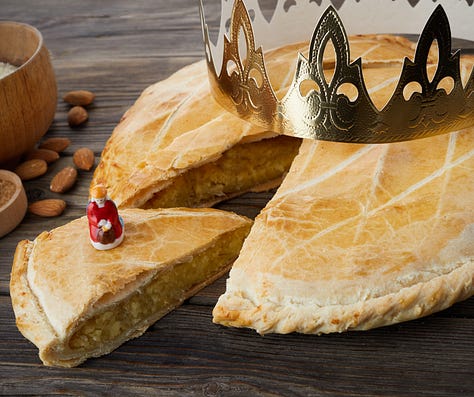
The Lord of Misrule
The King or Queen of Twelfth Night is a watered-down version of The Lord of Misrule who presided over Twelfth Night revelries, games, and plays during the Middle Ages, mirroring the Roman Saturnalia princeps tradition. Revellers would often dress up as animals or cross-dress, travelling door to door singing festive folk songs and telling jokes in the tradition of mumming or guising, which merged with the tradition of wassailing and evolved into the more ‘respectable’ tradition of carolling, which we will explore in next week’s article.
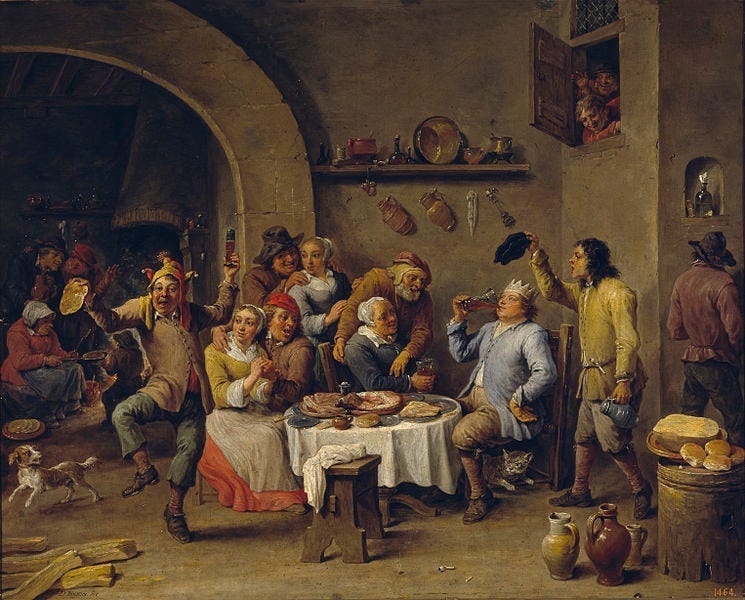
Feast of Fools
Twelfth Night traditions became so popular in medieval Europe that even the clergy celebrated their own Feast of Fools on 1 January, which involved role reversals that inverted the usual hierarchy, where a fool was turned into a pope and sub-deacons delivered sermons. The practice was condemned and banned in the 15th century as:
Priests and clerks may be seen wearing masks and monstrous visages at the hours of office… They dance in the choir dressed as women, panders or minstrels. They sing wanton songs. They eat black puddings… while the celebrant is saying mass. They play at dice… They run and leap through the church, without a blush at their own shame.
Unknown French theologian in 1445.
The Feast of Fools tradition originated in France in the 1100s and although it was banned in the 1400s, it was still a common tradition well into the 16th century. The Feast of Fools is described in Victor Hugo’s book The Hunchback of Notre Dame (1831), and depicted in Disney’s animated film of the same name, in which the protagonist, hunch-backed Quasimodo is ‘voluntold’ to be the King of Fools. Watch this short clip (2:17 mins) of Quasimodo’s election to the King of Fools for Topsy Turvy (Disney’s name for Feast of Fools).
Medieval traditions of Twelfth Night are recorded in many sources, including William Shakespeare’s play, Twelfth Night, which Queen Elizabeth I of England commissioned for the Twelfth Night celebrations at Whitehall Palace on 6 January 1601 to mark the end of the embassy of the Italian diplomat, the Duke of Orsino.
La Befana
In some regions of Italy, Twelfth Night or Epiphany on 6 January is celebrated by preparing for the arrival of La Befana. La Befana is a witch, often depicted as an old woman covered in soot, wearing a tattered shawl, who travels on a broomstick, visiting children’s homes during the night to deliver gifts and treats. Her name, Befana, is said to be derived from the Italian word Epifania (Epiphany). While La Befana has strong Christian ties, her story also has roots in pre-Christian traditions.
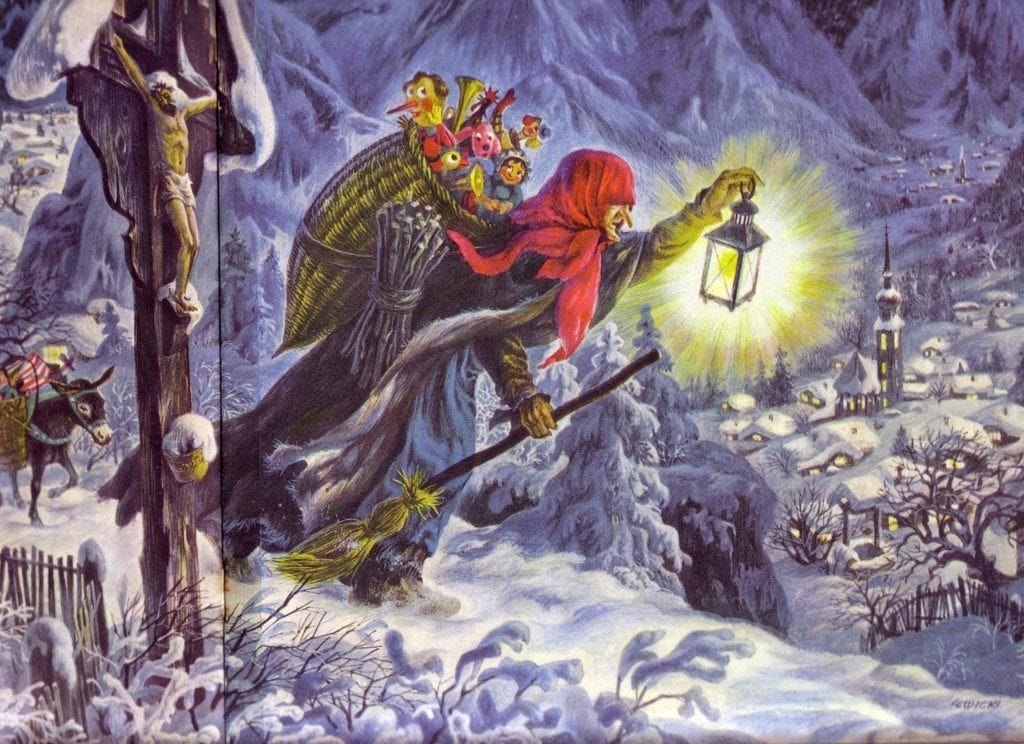
During the pre-Christian celebration of Saturnalia, the Roman goddess Strenia, associated with the New Year and gift-giving, was revered. It is believed that La Befana’s origins can be traced back to this pagan goddess. Over time, as Christian traditions merged with pagan customs, La Befana became associated with the Epiphany.
In Italy, the celebration of La Befana is marked by various customs and traditions. On the eve of January 6, children hang stockings or socks by the fireplace, hoping that La Befana will fill them with presents. It is believed that she enters through the chimney, just like Santa Claus. Some regions of Italy even hold parades and festivals in her honour, featuring witchy costumed performers and lively music.

Befana dolls are also sold at Christmas markets all over Italy.

I hope you enjoyed today’s article on the origin and evolution of Christmas, the Twelve Days of Christmas and Twelfth Night. In next week’s article, we will delve into the meanings and symbology behind decking the halls with evergreen plants, the origins of wassailing and their evolution into carolling, as well as the creepy but fascinating Welsh custom of the Mari Lwyd.
See you next week with our next article, Deck the Halls and Strike the Chorus!
¹ The Julian calendar used by ancient Romans meant that the winter solstice fell on 25 December, rather than 21/22 December in the Gregorian calendar that we currently use.





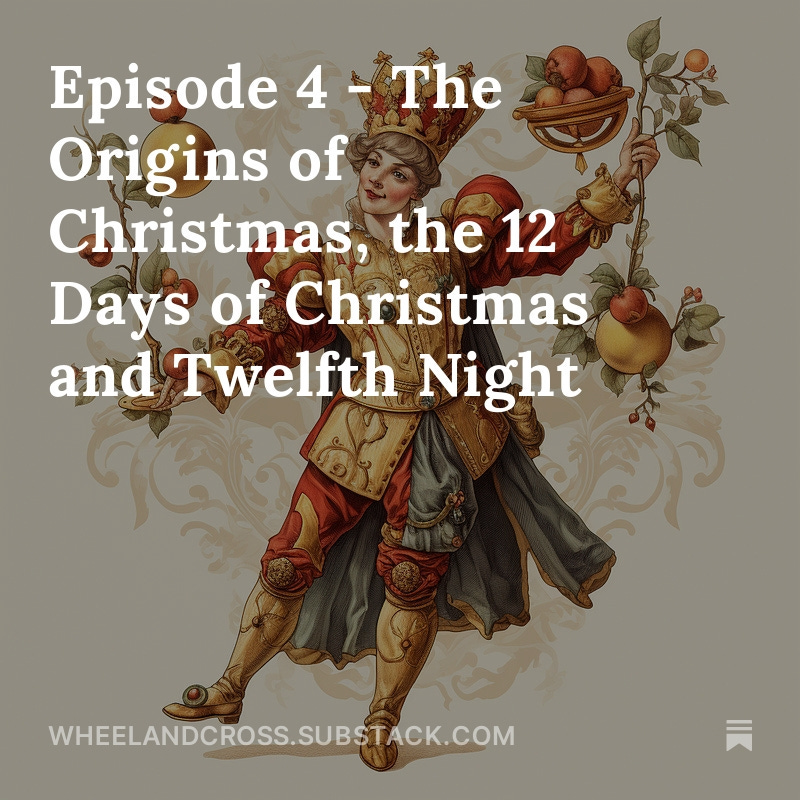
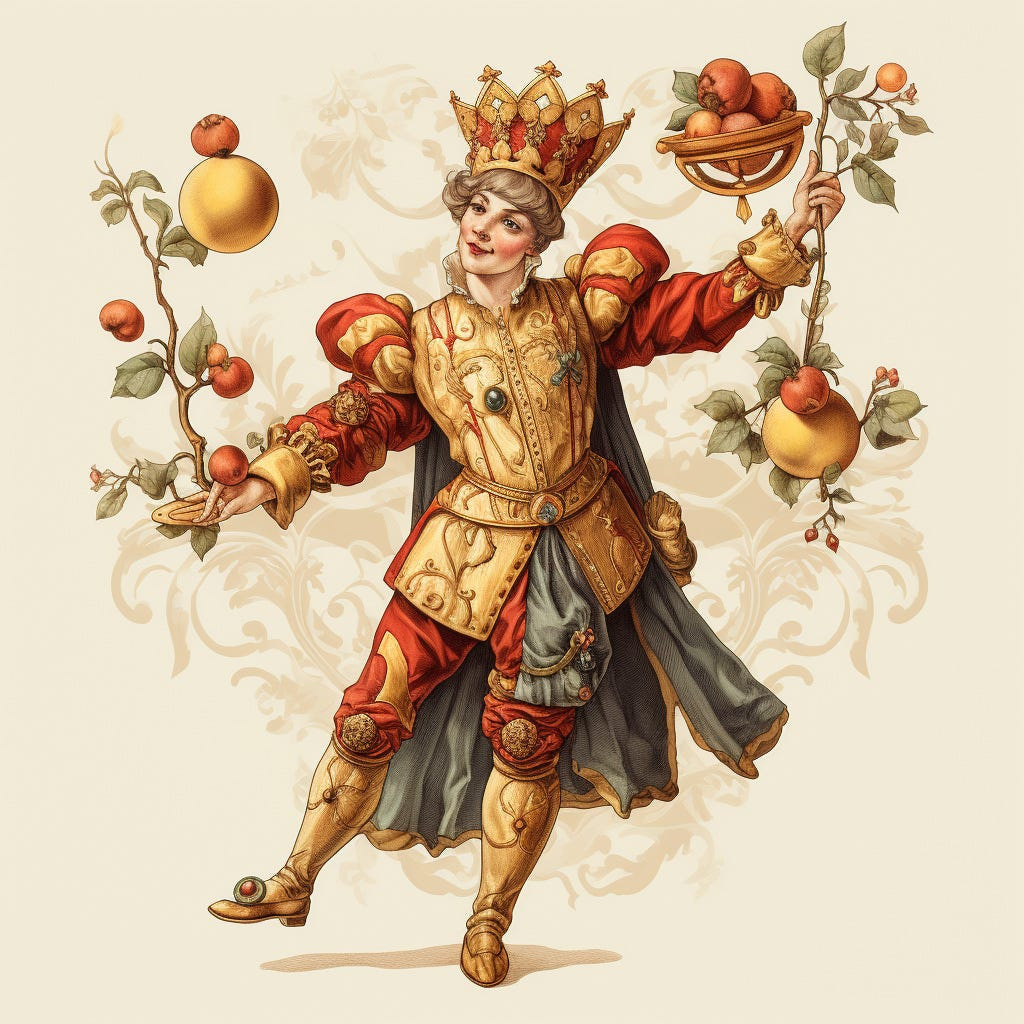










Share this post